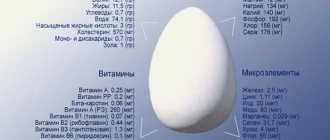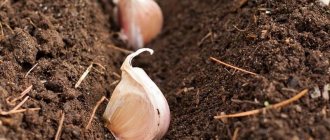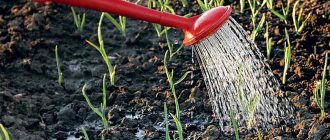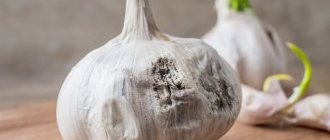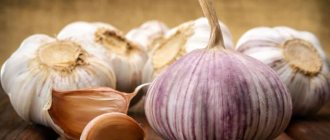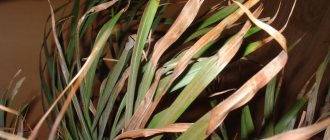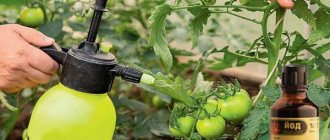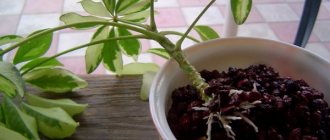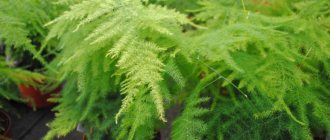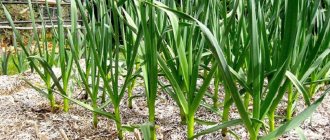Incorrect landing dates
Most often, gardeners grow winter varieties of garlic. They are not only the most common, but also produce the largest yield. Such garlic is planted in the beds in the fall, with the expectation that the cloves will go into winter rooted, but without releasing feathers.
If the cloves are planted in the ground too early, they have time to produce a green mass, which then gets frostbitten and turns yellow.
The correct choice of planting time will help eliminate the problem of yellowing of garlic leaves. The optimal timing of work varies depending on the region. They usually fall in mid-October - November. Earlier plantings are practiced in the north, later ones in the south.
Diseases and pests of garlic that cause yellowing of leaves
Another common cause of yellowing of garlic leaves is damage to the plant by one of the diseases and attack by pests, which primarily damages the bulb , in other words, this cause of yellowing poses a real danger to your future harvest. However, it is impossible to simply determine the presence of the disease by the color of the leaves; it is necessary to dig up and examine the bulb itself.
Worth understanding! Diseases and pests primarily attack weak plants, so do not skimp on feeding with mineral and/or organic fertilizers.
Fusarium, downy mildew and other diseases
This dangerous disease first leads to yellowing of garlic leaves, on which a pinkish coating of spores then appears. Next, the spores infect the bulb from the bottom and cause the roots to die. During storage, after a month, the affected bulbs become covered with white or pinkish mycelium (fungi) and rot.
Garlic is most affected by fusarium when planted after potatoes, in other words, crop rotation must always be observed .
Garlic can also be affected by peronosporosis (downy mildew) , bacteriosis, white and basal rot, black mold, mosaic, rust and other dangerous diseases.
By the way! Peronosporosis (downy mildew) is a fungal disease, which means it can be treated. So, to treat garlic against this disease (yellow spots appear on the leaves, and white fungal spores appear on the underside), you can spray the plants with Fitosporin , Trichodermin (all biological preparations), or Quadris (chemical fungicide), and it is better to do this as a preventive measure. purposes, i.e. even before yellowness appears in the form of spots.
Onion stem nematode
Another reason for yellowing leaves can be damage to garlic by stem nematodes. In this case, the garlic leaves not only turn yellow, but also subsequently die , and the affected garlic bulbs become loose and unsuitable for consumption and reproduction (future planting).
What to do in this case?
- Use only healthy planting material.
- Follow the rules of crop rotation and crop rotation.
Advice! The site already has detailed material about what is best to plant winter garlic after .
- To cleanse the soil of nematodes, you can plant marigolds or other strong-smelling plants that help repel pests, such as calendula .
By the way! Signs of nematode damage to garlic are often confused with the harmful activity of onion fly .
Onion fly
Important! The site already has a separate article on how to deal with onion flies in the garden .
Late frosts
A common reason why garlic turns yellow in the spring is the vagaries of the weather. During spring frosts, young tender leaves of plants are damaged by frost.
If the seedlings are still small, then they can be saved by mulching the soil - 5-7 cm from above will be quite enough. For small beds, you can limit yourself to temporary film cover. The use of stimulating drugs, such as Epin or Zircon, will help bring already damaged and yellowed garlic plantings back to life.
When cultivating spring varieties that are planted in April, care should also be taken. Sometimes it’s better not to rush and wait until May. If the weather forecast for spring in the region is unfavorable, you should not risk exposing your garlic to the risk of frostbite. In this case, the gardener will not have to guess why the garlic leaves in the garden have turned yellow.
Frosts, temperature changes, stress = yellowed (frozen) tips of garlic leaves
Some gardeners cite short-term return frosts as one of the most common reasons for the yellowing of the tips of garlic leaves in the spring, because of which they seem to “freeze”, and living tissue in them already dies.
However! Many do not agree with this opinion and see the reason, rather, in the fact that it is simply difficult for the root system to develop at low temperatures, so the plant’s development is inhibited, its leaves turn yellow, i.e. it is under stress due to lack of nutrition (it is not supplied).
It's another matter if you know there will be frosts. In this case, you should cover your garlic beds in advance , and after them, to maintain immunity, spray the leaves with one of the growth stimulants, for example, Epin or Zircon solution.
Note! In fact, there is nothing wrong with this: the garlic plants themselves will grow quite well, because garlic is a fairly winter-hardy and cold-resistant crop.
Video: Garlic leaves turn yellow in spring
Insufficient planting depth
Garlic is an unpretentious crop. But, nevertheless, agricultural technology is also important for him. If cloves are planted incorrectly in the soil, homeowners may notice that the plants look sick in the spring. This is due to shallow embedding of the seed into the soil, and as a result, freezing of the bulbs.
Outwardly, this may look like yellowing of the tips of garlic leaves or a change in color of the entire leaf blade of the plant. It turns light green or yellow.
To avoid this, it is necessary to plant garlic correctly; the planting depth of the cloves during autumn planting should be at least 4-6 cm. If there are frequent critical drops in temperature in the region, mandatory soil mulching should be used to prevent the garlic from freezing.
The following is used as mulch:
- humus;
- peat;
- straw;
- dry leaves.
The layer of covering material sufficient for successful overwintering of garlic should be at least 6 cm. Leaves and straw must be removed from the bed in the spring as the snow melts.
If the plants in the garden bed have already been damaged by frost and turned yellow in the spring, only high-quality intensive care throughout the spring will help them.
Failure to comply with agricultural practices and freezing
It is recommended to plant garlic before winter 35-45 days before frost. The roots will sprout, the plant will take root, but shoots will not appear, and it will survive the winter without problems. If planted later, the cloves will freeze, and if planted early, they will rot or produce weak, weakened shoots with yellow leaves.
Planting depth
The depth of embedding of the clove in the soil when planting before winter also plays a role. If planted shallowly, the soil will settle due to rain, and the garlic will be close to the surface, exposed to frost. Too much deepening will lead to rotting of the cloves due to the large amount of moisture in the soil in the spring and the inability to break through the thickness of the dense layer of earth. Or, having broken through to the surface, weakened seedlings begin to turn yellow.
You can determine the planting depth as follows: after embedding a clove in the ground, mentally place two more cloves of the same size above it - the top one should reach the surface. If this is the case, then the embedment depth is chosen correctly. Most often it is 12-15cm. It is recommended to cover the garden bed for the winter.
If it is suspected that spring frosts have affected garlic, treatment with biostimulants (Epin, Zircon), which affect root formation and disease resistance, is recommended.
Violation of watering standards
After the snow melts, when the top layer of soil dries, you need to loosen it to break up the crust that has formed on the surface - this helps to improve the passage of air into the lower layers.
There is no need to water until May; there is enough moisture in the ground. But, if the winter is snowless, when warm days come, the beds with garlic must be watered after loosening. In the future, focus on weather conditions: hot and dry - water more often, damp and cool - do not water.
How to water
- 10-12l per 1m² at t=13°-18° – every 10 days;
- at t=18°-25° the norms are the same, but reduce the interval to 6-7 days.
Starting from May, when the temperature is more stable, watering should be carried out regularly. Lack of moisture depletes the root system of garlic, the leaves gradually turn yellow.
Acidic soil
In the last days of August, preparation of the bed for winter garlic begins. The soil is dug up using the bayonet of a shovel, and mineral fertilizers and organic matter are applied at the same time. For garlic, soils with neutral acidity are the best. On acidic soils, the crop grows worse - the heads grow small, the leaves do not have a rich green color and, starting from the top, gradually turn yellow.
Knowing that garlic will be planted in this place, you need to start reducing the acidity in advance, until the crop preceding the garlic is planted. For deoxidation, 2-3 kg of lime (fluff) is added per 1 m². If lime is not added, then when preparing the ridge, add 0.7-3 kg of ash per 1 m² to the soil. The standards depend on the acidity level.
Lack of microelements
Often, snowy winters and heavy rainfall in autumn contribute to the leaching of nitrogen from the soil. With its deficiency, garlic leaves become less saturated in color and turn yellow. The plant can obtain nitrogen by fertilizing with organic matter or by applying nitrogen-containing fertilizers.
After the bed is cleared of snow, the first fertilizing necessary for growth is carried out - nitrogen fertilizers are applied. After 2 weeks, the next feeding is carried out. The third time you need to feed it during the period of intensive growth of the head - the second or third ten days of June. The last feeding should not be delayed in time - the plant will spend nutrients on the growth of the feather, and not on the growth of the head.
You may be interested in: When to plant garlic in the fall in central Russia according to the lunar calendar When to harvest garlic planted before winter in 2021 Timing for harvesting winter garlic in the Urals for storage in 2021
What and when to feed
- The first feeding is 2 liters of urea solution (1 tbsp per 10 liters) per 1 m² or a solution of mullein infusion in a ratio of 6:1.
- The second feeding is 3 liters of nitroammophoska or nitrophoska solution (2 tbsp per 10 liters) per 1 m². You can lightly loosen the soil near the rows of garlic, scatter the ash, then sprinkle it with soil. It is recommended to add ash three times during the growing season.
- The third feeding is 5 liters of solution (2 tablespoons of superphosphate and 200 g of ash per 10 liters) per 1 m².
Root feeding can be combined with foliar fertilization using complex formulations prepared in half dosage. Foliar feeding complements, but does not replace root feeding. With this method, the plant receives the necessary micro- and macroelements: potassium, phosphorus, nitrogen, magnesium, etc.
Information ! To fertilize garlic, you cannot use fertilizers with chlorine - it does not tolerate them well.
Garlic diseases
A garlic disease can be judged by the appearance of the plants - spots appear on the feathers, the rich green color changes to pale green or yellow. Signs of the disease in the underground part can be seen by digging up the head.
Diseases, signs and causes
- White rot. During a snowless winter, there is not enough moisture in the soil in the spring, and if it is also poor in nitrogen, then the combination of these reasons can cause white rot. Also, cold and wet weather gives impetus to the development of pathogens that live and remain active for a long time in the soil. You can notice the disease by the white coating at the base of the feather, which then turns yellow and dries out. A layer of mold is visible on the heads. Regular watering in dry spring and mineral fertilizing, for example, ammonium nitrate, will help prevent the disease. To treat soil and seeds, use preparations HOM, Maxim.
- Basal rot. The fungus that causes this disease is almost always present in the soil. When the immune system is weakened after some kind of stress (freezing, critical temperature changes, lack of watering or too damp acidic soil), infection occurs. The leaves begin to turn yellow from the top, but the rate of development of the disease is slower than with white rot. Sick plants are urgently removed from the garden. For prevention, garlic is treated with Thiram before planting.
- Penicillosis (blue or green mold). Early garlic is most often affected by infection through the air. The leaves change color, turn yellow, and the plant dies completely. The affected plant is removed from the garden bed, and the soil in this area is watered with a salt solution.
- Downy mildew. Pathogens are especially active in cool, damp weather and live for a long time in the soil. First, the leaves turn yellow, then a coating appears on them in the form of fluffy gray spots, the plant stops growing, and the leaves wrinkle. The affected leaves should be torn off, and if the infection is severe, the head should be removed. For prevention, biofungicides should be used.
- Gray (cervical) rot. Favorable conditions for its development are cool weather, moisture and excess nitrogen in the soil. The garlic cloves rot, and the manifestations of the disease become noticeable in the yellow leaves. Treat garlic with copper preparations before planting.
- Garlic rust. Infection with the fungus occurs through the soil in high humidity and hot weather. The infection can be spread by wind, infecting neighbors. Specks and yellow spots on the leaves indicate damage to the plant. For treatment, use Bordeaux mixture (1%) with the addition of a solution of soap, skim milk or ohm paste for adhesion, in a volume of ¼ of the total liquid. Prevention consists of treatment with formaldehyde (1:250) - the heads are placed in the solution, removed and dried for 2 hours.
Garlic pests
Despite the fact that garlic is used in the fight against garden insects and diseases, it itself is also susceptible to pests that can cause significant damage to the crop.
Aphid
Colonies of small insects, which are clearly visible, colonize the leaves of young garlic, sucking the juices from them. The leaf wrinkles, becomes pale, then turns yellow and dies. Aphids are also carriers of infections. The smell of mint planted nearby, or its crushed leaves spread between the rows, repel aphids.
Stem nematode
Stem nematode larvae survive winter in soil and plant debris. A worm, up to 1.5 mm long, emerging from them feeds on the sap of the plant. Longitudinal yellow stripes become visible on the leaves, then the leaf curls and dies, the head rots completely. Pull out the affected plant by the roots and dispose of it, treat the infected area with a salt solution.
For prevention, the soil before planting is spilled with a salt solution (20 g + 3 liters of water per 1 m²), and the seed cloves are kept in a solution of ash or salt for 2 hours.
Onion fly
Onion fly larvae penetrate the plant through the bottom of the head and feed on its pulp. The above-ground part turns yellow, withers and dies without receiving nutrition. They repel the onion fly with tobacco (5-6g per 1m²), red pepper (5-6g), ash (100-120g), scattering it around the plants.
The spraying solution has proven itself well: pour tobacco or shag (250-300g), ground pepper (10-20g) into a 3-liter container with hot water and leave for 2 days. Then add 20-25g of laundry soap and increase the volume to 10l.
Weevil
Female beetles lay eggs on the leaves (from below), and the larvae, when hatched, feed on the sap of the leaves. As a result, with a lack of nutrients, the leaves turn yellow at the top and dry out. Loosening the soil and scattering ash, ground pepper, and mustard over the surface helps.
Lack of nutrients in the soil
For the favorable growth of garlic, it is very important that from the very beginning it receives a sufficient amount of nitrogen, phosphorus and potassium, as well as the necessary trace elements at each stage of its development.
When this does not happen, the first signal for the gardener is a change in the color of the garlic leaf. If we exclude all previous factors, poor nutrition is the main reason why garlic turns yellow in the spring. Most often, plants at this time may lack nitrogen, as the main element for gaining green mass and growth. You should also not lose sight of the possibility of potassium-magnesium starvation, but, usually, it manifests itself a little later. Plants use these substances in small quantities at first, but as they grow, the need for them increases.
If the reason why your garlic turned yellow in the spring is due to insufficient nutrition, there are several options that can be done to return the plants to their normal healthy appearance. The lack of necessary substances must be compensated by applying fertilizers in liquid form (using foliar and root fertilizers) or by incorporating them into the soil.
Nitrogen deficiency
Yellowing of garlic leaves in the spring due to insufficient nitrogen in the soil can be easily eliminated by applying the necessary doses of fertilizers. Depending on their availability, you can use both organics and agrochemicals.
Natural fertilizers include:
- manure;
- chicken droppings.
They are diluted with water in a standard concentration and watered over the plants.
If the leaves turn yellow due to lack of nitrogen, you can also feed the garlic with mineral fertilizers. Complex preparations, for example “Kristallon” and potassium nitrate, have a good effect. Ammonium nitrate is a simple fertilizer.
Urea (carbamide) can also be applied to garlic in the spring, but it must be remembered that it will not become available to plants immediately, therefore, if planting assistance needs to be provided immediately, it is better to use nitrate forms of fertilizers. In addition to watering, it is permissible to incorporate dry matter into the soil followed by irrigation. The dosage of drugs required for application can be found on the packaging of the fertilizer; it is indicated by the manufacturer.
Lack of potassium and magnesium
If there is a lack of these important components in the soil, garlic also begins to turn yellow. Its leaves first lose their inherent dark green color, and then gradually dry out. In this case, you should water the garlic so that it does not turn yellow with the following preparations:
- potassium sulfate (potassium sulfate);
- potassium magnesia;
- kalimag;
- monopotassium phosphate.
Wood ash can be used as a natural fertilizer. To do this, pour 2 cups of powder into 10 liters of hot water, cool and filter. The resulting mixture is poured over the yellowed garlic. Or they scatter the ash evenly on the ground, and then water the bed well.
Why does garlic turn yellow in May - June?
The reasons may be the following:
- winter garlic fell under severe frost, which often occurs in May - early June;
- fungal disease on the bulb (easy to check - pull it out and inspect the bottom);
- the plant lacks nutrients (most often garlic leaves turn yellow if there is not enough potassium and nitrogen);
- insufficient watering (this often happens in June, when it is already warm enough);
- the soil is too dense, poor oxygen flow to the roots (loosening is necessary);
- pests - onion fly and secretive proboscis (they can be detected with the naked eye).
Have you decided on the reason? Then we urgently take action!
